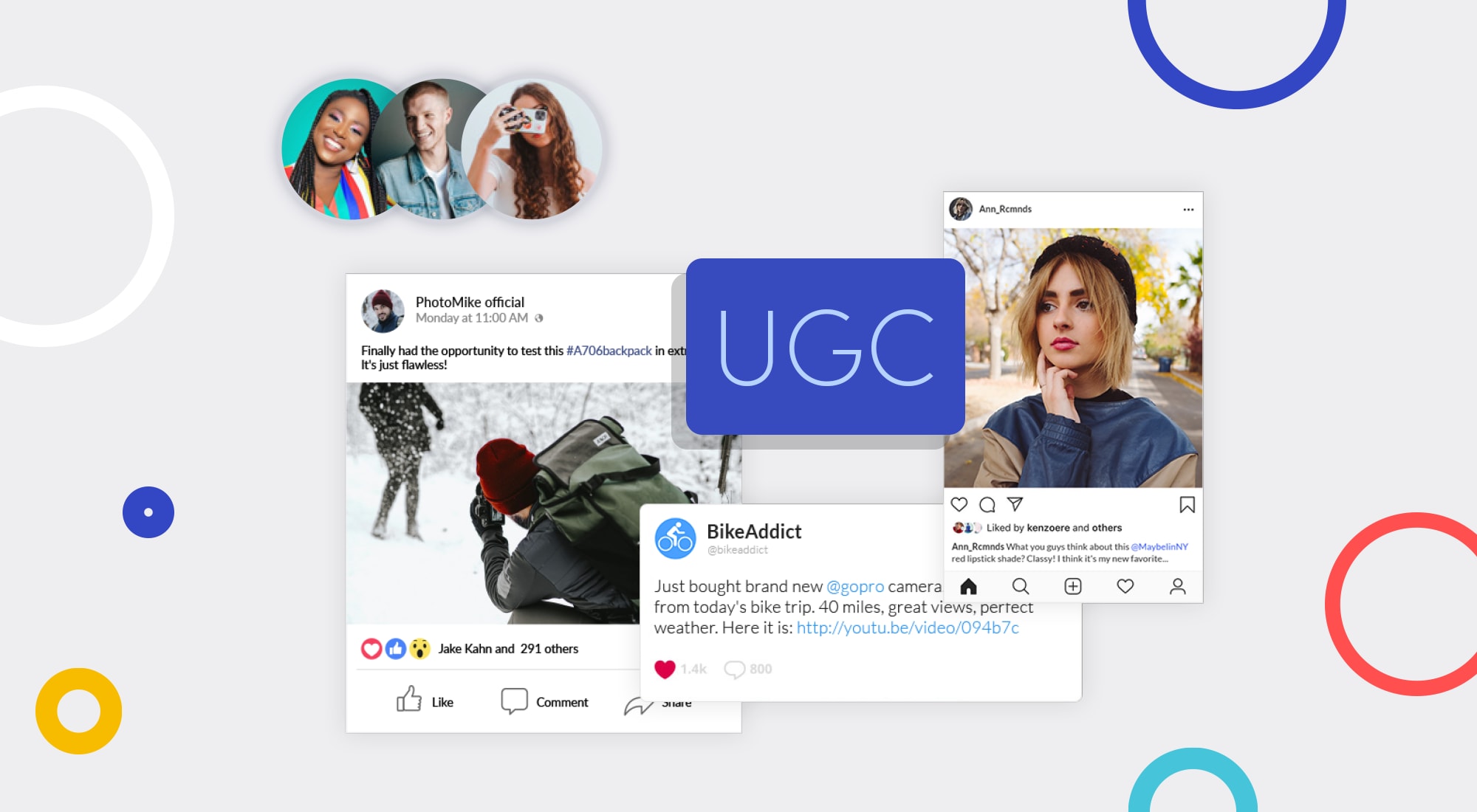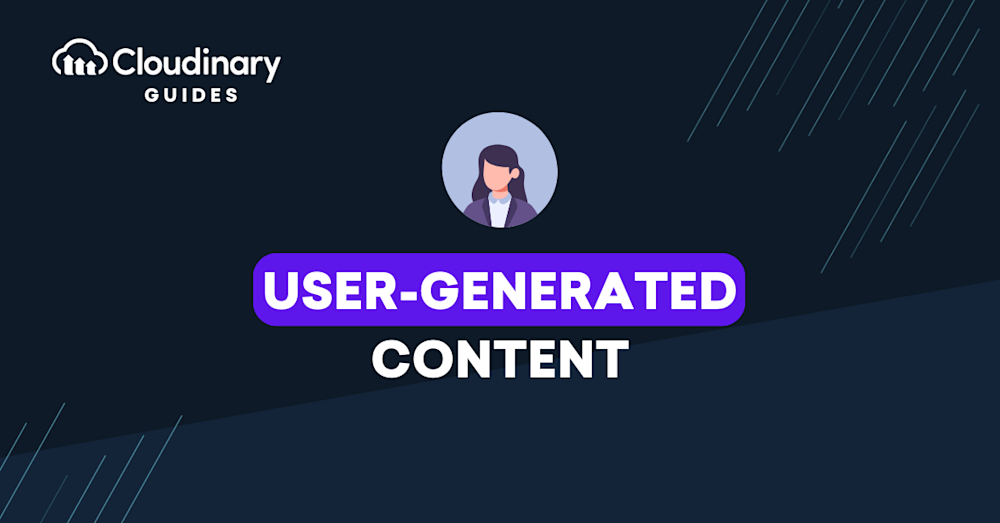What Is User-Generated Content?
User-generated content (UGC) is online content created by customers or prospective customers that relates to a particular product or brand. UGC can come in many forms, ranging from photos, videos, and social-media posts to high-production material like fan-made advertisements. A common example of UGC is a product-review video shared on YouTube. Another form of UGC that has gained traction is podcasts, where customers discuss or review products or brands.
Most brands rely primarily on social media to generate and distribute UGC. Toward that end, they contact consumers through social networks and encourage them to create UGC. Contributors can freely share the content they created with their followers, hence attracting a wider audience.
This is part of an extensive series of guides about Front-End Development.
This post explores the trends of UGC and the reasons why it is the most important marketing opportunity of this century for consumer brands, retailers, e-commerce shops, and such. Specifically, this post covers the following topics:
- Key Trends and Statistics
- Benefits of User-Generated Content
- Types of User-Generated Content
- Uses of User-Generated Content
- UGC Strategies: Seven Steps to Turn Customers Into Fans
- Management of UGC With Cloudinary

Key Trends and Statistics
Studies have found that UGC is on the rise and producing impressive results for marketing campaigns. In particular, the Global 2020 Cloudinary UGC Study showed that—
- Consumers are creating more UGC. Fifty-eight percent of consumers said that they generated more UGC in 2020 than the previous year.
- Consumers prefer visual content. Fifty-five percent of U.S. consumers said that photos are the primary type of content that influences their purchase decisions. Twenty-six percent cited written reviews as the most persuasive factor.
- Consumers prefer Facebook. Eighty-seven percent of U.S. consumers said that Facebook is the most informative social channel for researching purchases. Twenty-four percent preferred WhatsApp.
- Younger consumers use UGC more. Seventy-eight percent of Millennials, 70% of Generation Z, 52% of Baby Boomers, and 45% of the Silent Generation said that they rely on UGC for purchasing decisions.
Why User-Generated Content Is Important
User-generated content (UGC) plays a crucial role in modern marketing strategies, significantly impacting how brands engage with their audience and drive conversions. Here’s why UGC is indispensable for marketers:
Authenticity
In an era where consumers are highly selective about the brands they interact with, authenticity is paramount. UGC in marketing provides a level of authenticity that traditional advertising often lacks. Research shows that 86% of consumers are more likely to trust a brand that shares UGC. Authentic content from real customers builds trust and credibility, making it far more persuasive than influencer endorsements or conventional advertisements.
Brand Loyalty
UGC fosters a sense of community among your audience. When customers create content around your brand, they feel connected and valued, significantly boosting brand loyalty. This sense of belonging encourages deeper interactions and engagement between the brand and its consumers, ultimately leading to increased customer retention and brand advocacy.
Social Proof
Social proof is a psychological phenomenon where people mimic the actions of others. UGC serves as powerful social proof. When potential customers see existing customers enjoying and endorsing your products, they are more likely to trust your brand and consider making a purchase. Given the declining trust in traditional advertising, leveraging UGC is an effective way to build credibility and encourage new customers to try your products.
Content Curation
UGC is not confined to social media platforms. It can be seamlessly integrated into various marketing channels, enhancing your content curation strategy. By adding UGC images to cart abandonment emails or key landing pages, you can nudge prospective buyers to complete their purchases. For example, brands like Calvin Klein have dedicated UGC landing pages, showcasing real customers wearing their products, which helps to drive conversions.
Cost-Effectiveness
Creating high-quality marketing content can be expensive, especially when hiring influencers or agencies. UGC, however, is cost-effective. Encouraging your customers to share their experiences with your products costs little to nothing and provides a steady stream of engaging content for your brand. This approach is particularly beneficial for smaller brands or startups looking to maximize their marketing efforts without a hefty budget.
Benefits of User-Generated Content
Below are the key reasons why a growing number of brands are adopting UGC strategies as part of their marketing strategies.
UGC Is Authentic
By showing how people use your product in the real world, UGC lends credibility to your brand, enabling you to promote your product without overselling.
Authenticity wields a huge influence on consumers. According to Gartner, 84% of Millennials say that UGC sways their purchasing choices. In fact, 93% of customers believe user-generated content is very helpful when making a purchasing decision. What’s more, nearly half of Generation Z consumers count on social media as their primary source of information for what to buy—even more so than family and friends.
UGC Promotes Engagement
UGC is about connecting with consumers, building communities, and establishing dialogue between customers and brands. A Comscore study revealed that UGC attracts 28% more attention than standard brand posts.
Such a phenomenon is evident in all types of marketing content, including digital advertising. In fact, many brands included UGC content in paid advertising campaigns and, subsequently, saw a significant surge in metrics like clickthrough rates, conversions, and revenues.
UGC Drives Sales
Research shows that UGC is more likely to lead to sales than brand-generated content. Forbes reports that when brands incorporate UGC into their websites, their conversion rates rise by an average of 29%.
UGC Offers Audience Insights
By constantly interacting with customers and analyzing what they post about your brand, you gain a lot of insight into their preferences, likes, and dislikes. Not only do you improve customer relations through those engagements, but you can also enhance products and services based on the feedback.
Types of User-Generated Content
UGC comprises six main categories.
Photos and Videos
Because they cannot see products in real life, online consumers rely heavily on photos and videos to determine whether they want to own certain products (for example, clothing or gadgets) or experience the service (for example, restaurants or hotels).
Hence, high-quality images, video clips, and live streams are very important for consumers, especially young people. Research shows that a majority of Generation Z and Millennials base their purchasing decisions on photos and videos.
UGC in the form of rich media originates from the following sources:
- Customers. Pictures or videos posted in appreciation by customers who like your products are an ideal form of UGC. That’s because organic social-media posts from the general public that have used your products in real-world settings inspire shoppers and furnish concrete social proof of your products’ strengths.
- Advocates. These are people who not only buy your product but are also passionate about your brand, for example, members of your brand community and regular customers. Since advocates are enthusiastic about and familiar with your products, you could solicit their help in creating a specific type of UGC on an event or a specific product.
- Employees. Your employees, who represent your brand every day, are liable to create effective UGC for you. This type of content, called employee-generated content (EGC), can help you present your company culture—along with a unique and engaging professional perspective on your business—to the public.
Customer Ratings and Reviews
Since the late 1990s, customers on websites like Amazon, TripAdvisor, and Yelp have been able to publish product and service reviews online. Although not as attractive as visual media, UGC in the form of textual customer testimonials and reviews are of critical importance to virtually all consumer brands.
According to a BrandLocal survey of 5,000 consumers, 88% of online shoppers factor reviews into their buying decisions. That’s no surprise because accolades from customers and high product ratings can boost trust and your business’s reputation, assuring prospective customers about your products.
Blog Posts
Blogs that express opinions and share personal experiences are another popular avenue for UGC. If your product impresses bloggers, your brand name would often appear in their posts, potentially reaching hundreds or thousands of readers. No wonder that some companies ask well-known bloggers (influencers) to try their products, write about their experiences, and upload the posts in the form of UGC onto the company sites.
Besides, bloggers often share product tutorials and videos, which serve as user-generated advertisements for your brand, raising awareness for many potential customers.
Surveys
To better understand market needs, brands often conduct surveys before launching new products or services. Based on the responses, you can better understand your customers, meet their needs, and enhance your image.
You can also post on your site survey feedback as UGC in the form of charts, infographics, and statistics. A common tactic in surveys is to include open questions and encourage readers to express their views, which you can then leverage in promotions.
Gamification
Gamification, which gives the audience or potential customers a fun task to complete with the opportunity to earn a reward, is an attractive way in which to encourage users to participate in UGC campaigns. For example, you could hold a contest for the audience to submit photos of themselves that spotlight your brand in various situations, with a reward for the best contribution.
Brands frequently award levels, high scores, badges, leaderboards, and points to encourage site visitors to complete tasks and share achievements. You can also stimulate participation by offering special discounts to game winners, unlocking badges and offering membership to a VIP club. All those tactics, frequently employed in UGC campaigns, promise to foster participation and improve the quality of contributions.
Hashtag Campaigns
Hashtags are shareable labels that can attract more engagement and make your branded content easier to find. When users engage with your UGC campaign, they can add your brand’s hashtag, after which their followers who click it will be directed to other content marked with that hashtag.
Consider Cloudinary’s Digital Asset Management
Looking for a centralized location to manage all your media assets? Cloudinary’s Media Library makes it easy to upload, store, manage, and deliver images and videos efficiently.
Uses of User-Generated Content
Below are tips on where and how to leverage UGC.
E-commerce Product Pages
The most important moment for an e-commerce product is when consumers decide whether to add the product to their cart or to keep looking. You must structure e-commerce product pages in such a way that their content is compelling enough to raise the chance of conversion.
A great example of UGC is Lulus Fan Photos, which are sourced from fans and featured on product pages by the women’s clothing retailer Lulu. This UGC goes beyond the usual text descriptions or photos of professional models, showcasing instead images of products as they are worn by real women in their day-to-day life. The product pages provide useful context, including the height and weight of the people featured in the UGC fan photos, and the size of the items ordered.
Marketplaces
Marketplaces are such sites as Airbnb, eBay, Etsy, HomeAdvisor, Just Eat, and Zoopla, where content is provided by partners (homeowners, store owners, service providers, etc). Site visitors can browse listings for vacation rentals and apartments, purchase products, rate vendors, and search for dining, entertainment, and travel recommendations.
An example of UGC in professional marketplaces is walmart.com’s Bazaarvoice program, which connects brands and retailers with consumers with a personalized shopping experience. Through the Walmart Spark Reviewer program, sellers can send product samples to shoppers in the Walmart sampling community and solicit their reviews, which are then posted on Walmart.com. This is a reliable and scalable way to generate UGC and promote brands.
Social Media
We all have a general understanding of the types of content created by social-media users on core channels like Instagram, Facebook, Twitter, TikTok, YouTube, and dating apps. UGC videos on those channels have gained popularity by leaps and bounds in recent years. According to Mary Meeker’s Internet Trends report, Snapchat Lens viewers increased 20 times between 2017 and 2019, and Instagram and Facebook Stories grew by 100%. As mentioned, social media being a favorite among young people, it largely shapes their buying decisions.
An example of the use of UGC on social media is the TikTok challenge #InMyDenim, sponsored by Guess. The challenge asked TikTok users to take a video of themselves in Guess denim jeans with an overlay of the Bebe Rexha hit song *I’m a mess*. The challenge quickly went viral, logging over 50 million views.
UGC Strategies: Seven Steps to Turn Customers Into Fans
Take the following steps to build a robust strategy for your UGC campaign.
1. Identify Your Campaign Objectives
Before launching a UGC campaign, first define your needs and goals. Next, consider how UGC fits into your marketing strategy, i.e., you can leverage it to create brand awareness, obtain feedback about your products, or boost your brand’s image. Also, plan the duration of your campaign with specific timelines to meet your objectives.
2. Select a UGC Platform
Choosing the right UGC platform requires a good understanding of your target audience. By strategically sourcing and publishing UGC content, you can successfully meet the engagement objectives of your UGC campaign. For example, Facebook is commonly used for curated content and videos while Twitter is more appropriate for news and blog posts.
3. Communicate Your Intent
Let your audience know the kind of content you desire. Furthermore, encourage customers to generate content that will help you achieve the objectives of your campaign. For example, you could ask questions on social media along with clear guidelines. Additionally, you could distinguish the content between actual customers and potential customers.
4. Use Hashtags
Hashtags are shareable labels that can attract more engagement and make your branded content easier to find. When users engage with your UGC campaign, they can add your brand’s hashtag, after which their followers who click it will be directed to other content marked with that hashtag. To maximize the power of your UGC campaign, research your audience and competitors to pinpoint the popular hashtag phrases.
5. Build a Community
UGC marketing typically revolves around social media, enabling brands to build a community of followers. Sharing feedback from real customers helps you connect with them and engage with new customers. So, encourage your followers to communicate and share ideas, and be sure to respond to their take.
6. Moderate and Adjust
You might need to edit your UGC so that it’s consistent and first-rate before posting it on your website. Be mindful of the visual style, context (i.e., verifying that the images or videos contain only relevant information), and audio quality. Also, moderation is crucial for security. Ensure that users do not upload malware or share content that is inappropriate or harmful to your brand.
7. Monitor Performance
Track the performance of your UGC campaign to ascertain that it is progressing as planned. That way, you can discern the UGC’s quality and filter out irrelevant or fake content.
To that end, have in place clearly defined procedures for dealing with pranksters or inappropriate content. A UGC voting system can also help keep content in check, with the user community voting to accept or reject content that is submitted.
Management of UGC With Cloudinary
UGC images and videos are a key element brands must incorporate as part of an engaging web and mobile experience for consumers. To succeed in creating that experience, brands must aim for a seamless and automated workflow with efficient steps for uploads and moderations, dynamic transformations, and secure delivery across channels for optimal performance at scale. Fortunately, Cloudinary has you covered.
Cloudinary’s optimization and transformation capabilities, many of which are automated, render management of UGC efficient, intuitive, and effective. For details, see the following:
- User-Generated Content, Part 1: The Basics: The importance and benefits of UGC and the ways in which to leverage and deliver it for audience engagement and revenue growth.
- User-Generated Content, Part 2: Images and Their Transformations: The numerous automated options Cloudinary offers for optimized uploads, transformations, and delivery of UGC images for e-commerce.
- User-Generated Content, Part 3: Videos and Their Transformations: The ways in which to automate with Cloudinary the crucial management tasks—moderation, transcription, transformations, thumbnail creation—before posting UGC videos.
- User-Generated Content, Part 4: Security: The automated processes through which Cloudinary ensures that user-uploaded assets are secure and malware free, blurring irrelevant image background or text as you desire.
See Additional Guides on Key Front-End Development Topics
Together with our content partners, we have authored in-depth guides on several other topics that can also be useful as you explore the world of front-end development.
Responsive Images
Authored by Cloudinary
- 5 Techniques and Examples for Creating Responsive Images in CSS
- 3 Ways to Generate Responsive Image Backgrounds
- Responsive Images in HTML: A Practical Guide
Video Format
Authored by Cloudinary
- The Five Most Popular Web-Video Formats and Streaming Protocols
- The Popular Video Codes, Their Pros and Cons, and Related File Formats
- How the AV1 Codec Compresses Video for Efficient and High-Quality Delivery
Product Led Growth
Authored by Frontegg


